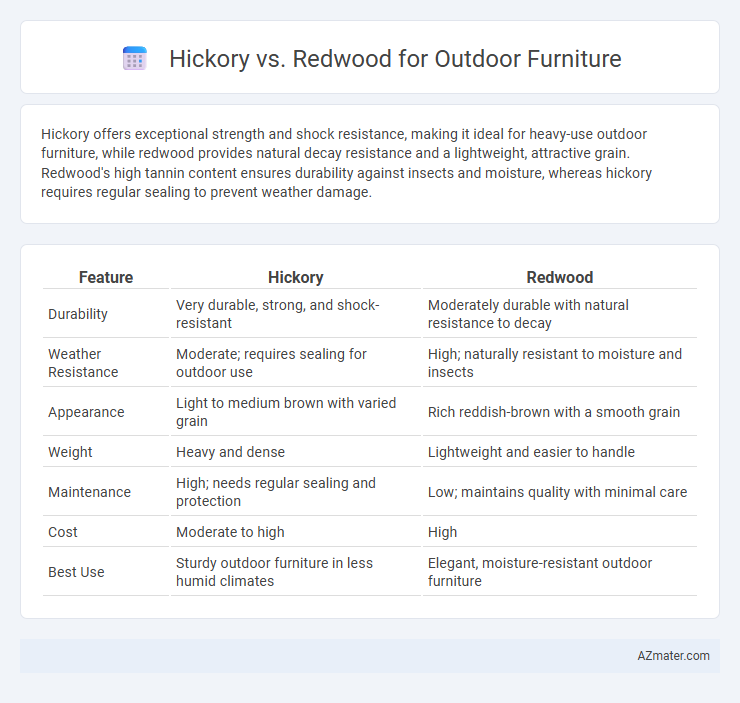Hickory offers exceptional strength and shock resistance, making it ideal for heavy-use outdoor furniture, while redwood provides natural decay resistance and a lightweight, attractive grain. Redwood's high tannin content ensures durability against insects and moisture, whereas hickory requires regular sealing to prevent weather damage.
Table of Comparison
| Feature | Hickory | Redwood |
|---|---|---|
| Durability | Very durable, strong, and shock-resistant | Moderately durable with natural resistance to decay |
| Weather Resistance | Moderate; requires sealing for outdoor use | High; naturally resistant to moisture and insects |
| Appearance | Light to medium brown with varied grain | Rich reddish-brown with a smooth grain |
| Weight | Heavy and dense | Lightweight and easier to handle |
| Maintenance | High; needs regular sealing and protection | Low; maintains quality with minimal care |
| Cost | Moderate to high | High |
| Best Use | Sturdy outdoor furniture in less humid climates | Elegant, moisture-resistant outdoor furniture |
Introduction: Comparing Hickory and Redwood for Outdoor Furniture
Hickory is known for its exceptional hardness and durability, making it ideal for outdoor furniture that withstands heavy use and weather exposure. Redwood offers natural resistance to decay and insects, featuring a rich reddish hue that enhances garden and patio aesthetics. Both woods provide unique benefits, with hickory excelling in strength and redwood prized for its longevity and natural beauty in outdoor environments.
Wood Characteristics: Hickory vs Redwood
Hickory is an incredibly dense hardwood known for its exceptional strength, shock resistance, and durability, making it ideal for heavy-use outdoor furniture. Redwood, by contrast, is a softwood prized for its natural resistance to moisture, decay, and insect damage due to high levels of tannins, providing longevity in damp environments. While hickory offers superior hardness and wear resistance, redwood's stability and weather resistance make it a preferred choice for outdoor settings exposed to varying climates.
Durability and Weather Resistance
Hickory outdoor furniture offers exceptional durability with a dense grain structure that resists impact and wear, making it ideal for high-traffic use. Redwood, known for its natural oils and high tannin content, provides superior weather resistance by effectively repelling moisture and preventing decay. Both woods withstand outdoor conditions well, but redwood's enhanced resistance to rot and insect damage often makes it the preferred choice for long-term outdoor furniture investment.
Aesthetic Appeal and Color Variations
Hickory offers a rich, warm tone with natural grain patterns that enhance outdoor furniture's rustic charm, aging gracefully with a light patina over time. Redwood provides a striking reddish hue that ranges from deep mahogany to softer pinkish tones, maintaining vibrant color when properly sealed. Both woods feature distinct aesthetic appeals, with hickory emphasizing rugged texture and redwood showcasing smooth, consistent coloration ideal for stylish, durable outdoor pieces.
Maintenance Requirements
Hickory outdoor furniture demands regular sealing and occasional sanding to maintain its durability and resistance to moisture, requiring more frequent maintenance compared to other hardwoods. Redwood offers natural resistance to decay and insects, requiring minimal upkeep such as annual cleaning and occasional resealing to preserve its rich color and structural integrity. Both require protective treatments to extend lifespan, but redwood's inherent properties make it a lower-maintenance option for outdoor use.
Cost Comparison: Hickory vs Redwood
Hickory outdoor furniture generally costs less than redwood due to the wood's abundance and faster growth rate, making it a budget-friendly option for durable outdoor pieces. Redwood furniture commands a higher price because of its natural resistance to decay, distinctive reddish hue, and limited availability, adding premium value to outdoor settings. When choosing between hickory and redwood, consider the balance of initial investment against long-term durability and aesthetic preference for outdoor furniture.
Sustainability and Environmental Impact
Hickory and redwood differ significantly in sustainability and environmental impact when used for outdoor furniture. Hickory, often harvested from fast-growing hardwood forests, supports sustainable forestry practices but requires chemical treatments to enhance its natural durability. Redwood is naturally resistant to decay and pests, often sourced from well-managed plantations, making it an eco-friendly choice with a lower carbon footprint due to minimal chemical use and long lifespan in outdoor settings.
Weight and Ease of Handling
Hickory outdoor furniture is notably heavier than redwood, with its dense grain contributing to substantial weight that can challenge mobility. Redwood's lighter weight and natural resistance to warping make it easier to handle and rearrange, ideal for dynamic outdoor spaces. Despite hickory's durability, redwood's ease of handling and lower density provide a practical advantage for outdoor furniture in terms of portability.
Availability and Sourcing
Hickory is widely available in North America, primarily sourced from eastern U.S. forests, making it a cost-effective option for outdoor furniture due to its regional abundance and quicker growth cycle. Redwood, sourced mainly from the coastal regions of California, is less abundant and more expensive, with strict harvesting regulations that limit supply to preserve old-growth forests. The sustainability concerns and limited plantations impact redwood's availability, making hickory a more accessible choice for durable outdoor furniture.
Best Uses: Which Wood is Right for Your Outdoor Furniture?
Hickory offers exceptional strength and shock resistance, making it ideal for outdoor furniture subjected to heavy use such as picnic tables and benches. Redwood's natural decay resistance and rich color make it perfect for decorative pieces like Adirondack chairs and garden benches, where aesthetics and weather durability are essential. Choose hickory for durability under high stress and redwood for elegant, weather-resistant outdoor furniture.

Infographic: Hickory vs Redwood for Outdoor Furniture
 azmater.com
azmater.com